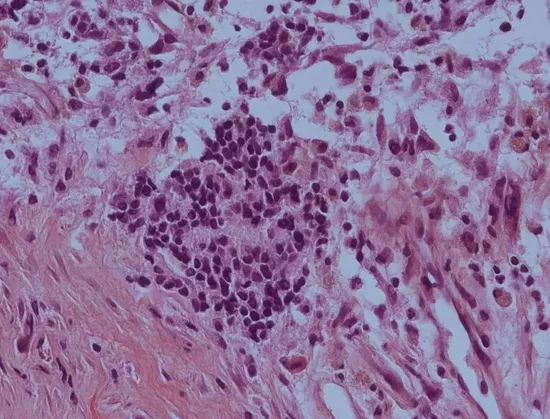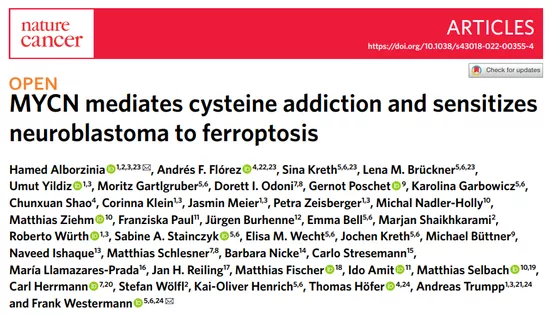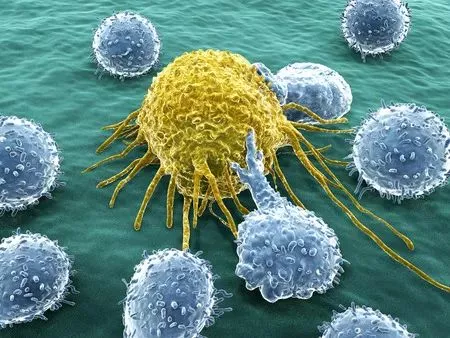When Babies Born Less Than A Year Ago Are Diagnosed With Life-threatening Cancer, It Is Undoubtedly A Bolt From The Blue For The Whole Family. But It Is Puzzling That Some Of These Children's Symptoms Will Change Miraculously: Without Treatment, Their Tumors Will Disappear By Themselves.
These Children Are Suffering From A Very Dangerous And Common Tumor - Neuroblastoma. This Is The Most Common Extracranial Solid Tumor In Infants And Young Children. Neuroblastoma Accounts For 15% Of Infant Cases Caused By Cancer.
The Origin Of These Tumors Can Be Traced Back To Embryonic Development And Formed In Undifferentiated Sympathetic Ganglion Cells. Therefore, Neuroblastoma May Occur In The Adrenal Gland, Spine, Neck, Chest And Abdomen Where There Are Sympathetic Ganglia. Subsequently, The Tumor Can Metastasize To Multiple Parts Of The Body And Develop Resistance To Chemotherapy.

▲ Aggressive Neuroblastoma Cells Gather In The Tissue (image Source: Reference [2 ]; Credit: Frank Westermann / DKFZ)
The Result Is That For A Considerable Number Of High-risk Neuroblastoma Children, Even If They Receive High-intensity Treatment, It Is Difficult To Effectively Control The Tumor For A Long Time. Many Children Were Killed By Cancer Before They Could Feel The Beauty Of The World.
However, In Children With Neuroblastoma, There Are A Small Number Of Lucky Children. Even If They Do Not Receive Any Treatment, The Tumor Will Disappear By Itself. Why Is Neuroblastoma So Different In Different Children?
In A Study Published In Nature Cancer, Scientists From Institutions Such As The German Cancer Research Center (DKFZ) Challenged The Problem. They Found That The Loss Of An Amino Acid May Explain The Disappearance Of Cancer Cells In These Children.

This Discovery Starts With MYCN Gene, A Member Of Oncogene Family That Has Attracted Much Attention Recently. Recent Studies Have Pointed Out That As A Regulatory Factor In The Direction Of Disease Development, MYCN Gene Determines Whether Precursor Cells Will Develop Into Mature Nerve Cells Or Malignant Neuroblastoma.
The Genome Of Malignant Neuroblastoma Carries Hundreds Of Active Copies Of MYCN Gene. Its High Activity Leads To A Significant Change In Cancer Cell Metabolism. But The Question Is, What Benefits Does This Gene Bring To Cancer Cells? If The Action Process Of MYCN Gene Can Be Terminated, Can The Process Of Cancer Be Stopped?
Based On This Idea, The Research Team Studied The Role Of MYCN Gene In Neuroblastoma. They Found That MYCN Highly Active Neuroblastoma Cells Have An Exceptionally Strong Demand For Cysteine.
For Most Cells, Cysteine Is An Important Structural Unit Of Proteins And Lipids. The Rapidly Proliferating Cancer Cells Obviously Need These Proteins And Lipids To Produce New Cells.
On The Other Hand, Cancer Cells Also Need Cysteine To Protect Themselves And Remove A Large Number Of Peroxide Toxins Produced By Highly Active Metabolism. When Neuroblastoma Cells Lack Cysteine, They Obtain It In Two Ways: Using Amino Acids Ingested By The Host, Or Using Methionine To Produce Cysteine Through Another Synthetic Path.
The Dependence Of Neuroblastoma Cells On Cysteine Reminds The Research Team That If Cysteine Is Artificially Deprived, Peroxide Toxins Will Begin To Accumulate In MYCN Driven Tumor Cells, Leading To Cell Iron Death. Therefore, Cysteine May Be The Achilles Heel Of Malignant Neuroblastoma.

To Test This Hypothesis, In Mouse Experiments, The Team Blocked The Uptake And Synthesis Of Cysteine And Inactivated A Class Of Enzymes Used To Consume Peroxide. At This Time, Due To The Large Accumulation Of Peroxide, Cancer Cells Can Start The Self Destruction Process Through Iron Death, And The Tumor Will Shrink.
This Study Is The First To Confirm That Iron Death Can Be Used To Kill Highly Invasive Neuroblastoma Cells In Cancer Mice.
The Same Process May Explain The Spontaneous Disappearance Of Cancer Cells In Some Children With Neuroblastoma. "In The First Year Of Life, Cells Usually Get Less Cysteine. Therefore, When These Cells Begin To Divide Uncontrollably, Their Cysteine Reservoir Is Quickly Emptied, So Iron Death Is Initiated." Dr. Hamed Alborzinia, CO Corresponding Author Of The Paper, Explained. Some MYCN Inactive Neuroblastomas Cannot Get Rid Of The Outcome Of Self Clearance And Die When Cysteine Deficiency Reaches A Certain Stage.
For Those High-risk Patients With Highly Active MYCN Gene, This Study Not Only Provides A New Understanding Of The Balance Of Cysteine Intake, Production And Consumption, But Also Provides A New Idea For More Researchers To Start The Self Destruction Process Of Cancer Cells. We Hope That Through Future Clinical Trials, This Process Will Really Be Used To Treat Children With Neuroblastoma, So That Those Unfortunate Children Can Grow Up Healthily And Feel The Beauty Of The World.
Reference Material:
[1] Alborzinia, H。, Flórez, A.F。, Kreth, S。 et al。 MYCN mediates cysteine addiction and sensitizes neuroblastoma to ferroptosis。 Nat Cancer 3, 471–485 (2022)。 https://doi.org/10.1038/s43018-022-00355-4
[2] Tumors on withdrawal: Amino acid deficiency shrinks childhood tumors。 Retrieved Apr 28th, 2022 from https://www.dkfz.de/en/presse/pressemitteilungen/2022/dkfz-pm-22-27-Tumors-on-withdrawal-Amino-acid-deficiency-shrinks-childhood-tumors.php
This Article Is From Wuxi Apptec Content Wechat Team
